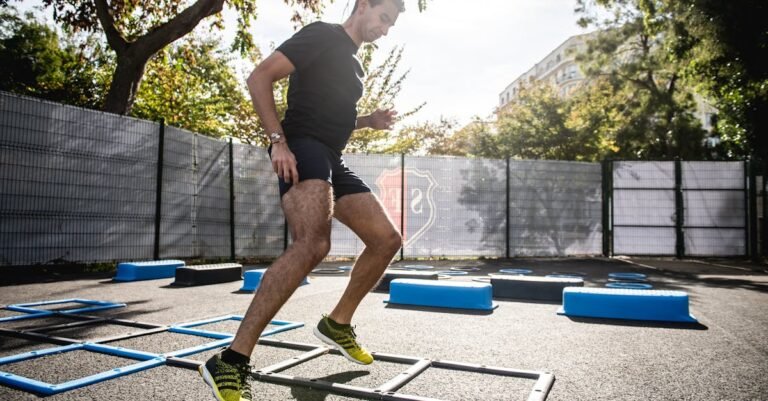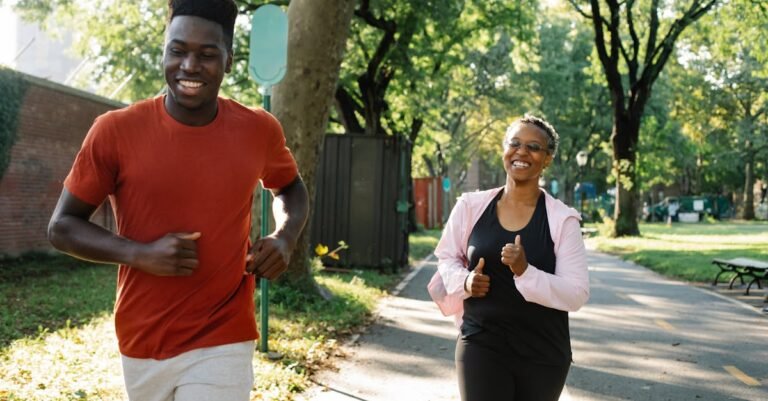Table of Content
- Running Tips For Beginners: Start Slow
- Why Starting Slow is Crucial for New Runners
- Getting Started: Your First Steps (Literally!)
- Mastering the Pace: Finding Your “Slow”
- Essential Running Form Basics for Beginners
- Listening to Your Body: The Ultimate Guide
- Building Consistency: The Long Game
- Beyond the Run: Warm ups, Cool downs, and Stretching
- Conclusion: Embrace the Journey, One Slow Step at a Time
- Frequently Asked Questions (FAQs)
Running Tips For Beginners: Start Slow
So, you want to become a runner? Awesome! Joining the running community is fantastic – fresh air, improved fitness, maybe even a cool medal or two down the line. But hold your horses (or should I say, slow your stride?). Before you lace up and sprint out the door like you’re chasing an ice cream truck, let’s talk about the single most important piece of advice for any beginner: start slow.
I know, I know. You see those experienced runners gliding effortlessly down the path, and you think, “I want to do that!” The enthusiasm is brilliant, truly. But channeling that energy correctly is key. Trying to do too much, too soon is the fastest way to end up injured, burnt out, and hating the very thought of running. Trust me on this one; many of us learned this the hard way. This guide is all about helping you build a lasting, enjoyable relationship with running by embracing the power of starting slow.
Why Starting Slow is Crucial for New Runners
Think of starting running like building a house. You wouldn’t just throw up the walls and roof on day one without laying a solid foundation, right? Starting slow is your foundation. It allows your body – your muscles, tendons, ligaments, bones, and even your cardiovascular system – to adapt gradually to the new stresses of running. Going full throttle from the get go is like building on sand; it’s just asking for trouble.
Avoiding the Dreaded Injury Bug
This is probably the biggest reason to take it easy. Running is a high impact activity. With every stride, your body absorbs a force several times your body weight. If your tissues aren’t prepared for that load, something’s gotta give. Common beginner running injuries like shin splints, runner’s knee, Achilles tendinitis, and stress fractures often stem from ramping up mileage or intensity too quickly. Starting slow gives your body the precious time it needs to strengthen and become resilient. It’s like tempering steel – a gradual process makes it stronger. Rushing it just makes it brittle.
Building Mental Toughness Gradually
Running isn’t just physical; it’s a huge mental game too. When you first start, even a short run can feel challenging. There will be days when your brain screams at you to stop long before your body actually needs to. By starting slow and achieving small, manageable goals (like running for 1 minute straight, then 2, then 5), you build confidence. Each small victory reinforces the idea that you *can* do this. Pushing yourself into the “pain cave” too early can be incredibly demoralizing and make you want to quit before you’ve even really begun. Slow progress builds sustainable motivation.
Making Running Enjoyable (Not a Chore!)
Let’s be honest: if every run leaves you gasping for air, sides aching, feeling utterly defeated, are you going to stick with it? Probably not! Running shouldn’t feel like torture. When you start slow, you can actually enjoy the process. You can notice your surroundings, listen to music or a podcast, maybe even run with a friend and chat (more on that later!). Keeping the effort level comfortable, especially in the beginning, associates running with positive feelings rather than pain and struggle. This positive reinforcement is crucial for building a long term habit.
Getting Started: Your First Steps (Literally!)
Okay, convinced that slow is the way to go? Brilliant! Let’s get you ready to take those first crucial steps.
Choosing the Right Running Gear
You don’t need a mountain of fancy gear to start running, but a couple of key items can make a world of difference.
The Importance of Proper Running Shoes
If there’s one place to invest, it’s your shoes. Your trusty old sneakers or fashion trainers just won’t cut it. Running shoes are specifically designed to provide the cushioning and support needed to handle the repetitive impact of running. Wearing the wrong shoes is like trying to hammer a nail with a screwdriver – it’s inefficient and likely to cause damage.
What makes a shoe “proper”? It really depends on *your* feet. Consider visiting a specialist running store where staff can analyze your gait (how your foot moves when you run) and recommend shoes that suit your biomechanics. They’ll look at things like arch height and pronation (the natural inward roll of your foot). Don’t just buy based on looks or brand; focus on comfort and fit. Your feet will thank you profusely.
Comfortable Clothing: Function Over Fashion
You don’t need the latest high tech compression gear right away. The main thing is comfort and avoiding cotton. Why no cotton? Cotton absorbs sweat like a sponge and holds onto it, leading to chafing (ouch!) and making you feel heavy and damp. Look for technical fabrics (often polyester or blends) designed to wick moisture away from your skin. Choose clothes that allow for a full range of motion and are appropriate for the weather. Layers are great for colder conditions.
The Magic of the Walk/Run Method
Ready to hit the pavement? Forget trying to run continuously for miles right off the bat. The walk/run method is your best friend as a beginner. It’s a proven, gentle way to build your running endurance without overwhelming your system.
What is the Walk/Run Method?
It’s exactly what it sounds like: you alternate between short intervals of running and intervals of walking. The running intervals gradually build your cardiovascular fitness and strengthen running specific muscles, while the walking intervals allow you to recover, catch your breath, and keep your overall effort level manageable. It reduces the overall impact on your body compared to continuous running, significantly lowering injury risk.
Think of it like interval training, but focused purely on building an aerobic base safely. It allows you to cover more distance or stay out for longer than you could if you tried to run continuously, which is great for both physical adaptation and mental confidence.
Sample Walk/Run Schedules
Here’s a very basic example to get you started. Remember to warm up with a 5 minute brisk walk before each session and cool down with a 5 minute walk afterwards.
- Week 1: Run 1 minute, Walk 2 minutes. Repeat 8 times. (Total running: 8 mins)
- Week 2: Run 2 minutes, Walk 2 minutes. Repeat 7 times. (Total running: 14 mins)
- Week 3: Run 3 minutes, Walk 2 minutes. Repeat 6 times. (Total running: 18 mins)
- Week 4: Run 4 minutes, Walk 1 minute. Repeat 6 times. (Total running: 24 mins)
This is just a template! The key is to listen to your body. If a week feels too hard, repeat it. If it feels ridiculously easy, you *might* consider slightly increasing the run interval or decreasing the walk interval the following week, but always err on the side of caution. Aim for 3 sessions per week on non consecutive days to allow for recovery. Consistency is more important than speed of progression.
Mastering the Pace: Finding Your “Slow”
Okay, we keep saying “start slow,” but what does “slow” actually mean? It’s relative, of course! Your slow might be someone else’s fast, and vice versa. The goal isn’t to hit a specific number on a watch, but to find an effort level that’s sustainable and comfortable for *you* right now.
The Conversational Pace Test
This is the gold standard for finding your easy pace, especially when starting out. During your running intervals (or your continuous runs, once you get there), you should be able to speak in complete sentences without gasping for breath. If you can sing an opera, you’re probably going too slow (or you’re a very fit opera singer!). If you can only manage one or two word answers, you’re going too fast. Aim for being able to chat comfortably. If running alone, try reciting something out loud or singing along (quietly!) to your music.
This ensures you’re running aerobically – using oxygen efficiently to produce energy. Pushing into anaerobic territory (where you can’t get enough oxygen) too often as a beginner is counterproductive and stressful for your body.
Forget Speed, Focus on Time or Distance
Seriously, ditch the stopwatch obsession for now. Focusing on pace (minutes per mile or kilometer) as a beginner is often discouraging and pushes you to run faster than you should. Instead, focus on the duration of your run/walk intervals or the total time you’re out exercising. Aim to complete your planned workout, whatever the pace. You can also focus on covering a specific, short distance using the walk/run method. The speed will come naturally as your fitness improves over weeks and months. Patience, young grasshopper!
Essential Running Form Basics for Beginners
While you don’t need perfect form from day one, being mindful of a few basics can help prevent injuries and make running feel more efficient, even at a slow pace.
Posture and Alignment: Stand Tall
Think tall! Imagine a string pulling you up from the crown of your head. Keep your head up, looking ahead (not down at your feet), relax your shoulders away from your ears, and engage your core slightly. Avoid hunching over or leaning too far forward from the waist. A slight forward lean from the ankles is okay, letting gravity assist you gently. Keep your arms bent at roughly 90 degrees and swing them forwards and backwards, not across your body.
Foot Strike: What You Need to Know (For Now)
There’s endless debate about heel striking vs. midfoot vs. forefoot striking. Honestly? As a beginner starting slow, don’t overthink this *too* much. The most important thing is to avoid “overstriding” – reaching your foot way out in front of your body, which often leads to a harsh heel strike and acts like a braking force. Try to land your foot more or less underneath your body, beneath your center of gravity. Running at a slower pace and focusing on a quicker, lighter cadence (steps per minute) often naturally encourages a more midfoot landing. Don’t force a change; just focus on landing softly and avoiding that jarring, outstretched leg landing.
Listening to Your Body: The Ultimate Guide
This might be the most crucial skill you develop as a runner. Your body is constantly giving you feedback; you just need to learn how to interpret it.
Recognizing Good Pain vs. Bad Pain
It’s normal to feel some muscle soreness or fatigue when you start a new exercise program. This is often “good pain” – the feeling of muscles adapting and getting stronger (often called DOMS – Delayed Onset Muscle Soreness). It usually feels like a dull ache, affects muscles on both sides of the body, and eases off within a day or two or with light activity.
“Bad pain,” on the other hand, is your body’s warning signal. It might be sharp, stabbing, or localized to a specific point (especially in a joint or bone). It might get worse *during* or *after* running, persist for days, or cause you to limp or alter your gait. Never run through bad pain. Stop, rest, and if it doesn’t improve, seek advice from a doctor or physical therapist. Ignoring warning signs is a surefire way to turn a minor niggle into a long term injury.
Building Consistency: The Long Game
Progress in running comes from consistency, not intensity (especially early on). Aiming for three shorter, slower runs per week is far more beneficial than one heroic, exhausting long run followed by a week off recovering. Life happens, of course – you might miss a run occasionally. Don’t beat yourself up. Just get back on track with your next scheduled run. But try to establish a routine. Schedule your runs like any other important appointment. Laying out your clothes the night before can also help overcome morning inertia. Remember, you’re building a habit, and habits thrive on regularity.
Beyond the Run: Warm ups, Cool downs, and Stretching
What you do before and after your run is almost as important as the run itself, particularly when you’re asking your body to adapt.
Dynamic Warm ups: Preparing Your Muscles
Forget those old school static stretches (holding a stretch for 30 seconds) before you run. Research suggests that pre run static stretching can actually decrease performance and potentially increase injury risk. Instead, focus on dynamic warm ups. These involve active movements that prepare your muscles for the specific demands of running. Think 5 minutes of brisk walking followed by things like leg swings (forward/back and side to side), walking lunges, high knees, butt kicks, and torso twists. The goal is to increase blood flow, raise muscle temperature, and improve range of motion.
Static Stretching: Post Run Recovery
After your run, once your muscles are warm and pliable, is a better time for some gentle static stretching. Hold each stretch for 15 to 30 seconds, focusing on major muscle groups used in running: quadriceps, hamstrings, calves, hip flexors, and glutes. Don’t bounce, and only stretch to the point of mild tension, not pain. A cool down walk (5 minutes) before stretching helps gradually bring your heart rate down. Stretching can help improve flexibility and potentially reduce post run muscle soreness.
Conclusion: Embrace the Journey, One Slow Step at a Time
Becoming a runner is a marathon, not a sprint – even if you only ever plan on running short distances! The “start slow” philosophy isn’t about holding you back; it’s about setting you up for long term success and enjoyment. By respecting your body’s adaptation process, using the walk/run method, finding your conversational pace, listening to your body, and being consistent, you build a solid foundation.
Don’t compare yourself to others. Your journey is unique. Celebrate the small victories – completing your first walk/run session, running for 5 minutes straight, finishing your first continuous mile. Embrace the process, enjoy the feeling of getting fitter and stronger gradually, and remember why you started. Running can be an incredible source of joy, stress relief, and accomplishment. Take it slow, be patient, and soon you’ll be well on your way. Happy running!
Frequently Asked Questions (FAQs)
1. How slow is *too* slow when starting running?
Honestly, for a complete beginner, there’s barely such a thing as “too slow” for the running portions. If you can maintain a running motion (even a gentle jog), and it feels different from walking, you’re doing it right. Focus on the conversational pace test – if you can chat, your pace is likely perfect for building your aerobic base safely. Don’t worry about speed; focus on completing the time or distance planned.
2. I feel fine, can I skip the walk breaks sooner?
It’s tempting, especially on good days! But sticking to a gradual progression plan, even if it feels easy sometimes, is crucial for injury prevention. Your cardiovascular system often adapts faster than your muscles, tendons, and bones. Feeling good aerobically doesn’t mean your tissues are ready for the increased impact of continuous running yet. Patience now prevents sidelined weeks or months later.
3. Do I need to run every day as a beginner?
Absolutely not! Rest days are just as important as run days. They allow your body to repair and rebuild stronger. For beginners, 3 running days per week on non consecutive days (e.g., Tuesday, Thursday, Saturday) is generally recommended. This provides enough stimulus for adaptation without overdoing it.
4. What if I get a side stitch while running?
Side stitches (sharp pain below the ribs) are common, especially for beginners. Theories vary, but they might relate to diaphragm spasms or breathing patterns. If you get one, try slowing down or walking. Deep, diaphragmatic breathing (belly breathing) can help prevent them. Sometimes, gently pressing on the affected area or stretching your arm overhead on that side can provide relief. Ensuring you’re well hydrated and not eating too close to your run might also help.
5. When can I start increasing my running time or distance?
The general rule of thumb is the “10% rule,” meaning you shouldn’t increase your total weekly mileage or your longest run by more than 10% per week. For absolute beginners using walk/run, a more practical approach is to stick with a plan (like the samples above) that gradually increases the run intervals and decreases the walk intervals over several weeks. Listen to your body – if you feel consistently good with no warning pains, you can progress. If you feel overly fatigued or sore, repeat a week or take an extra rest day.










